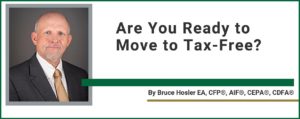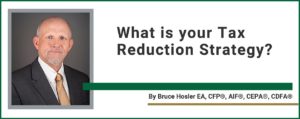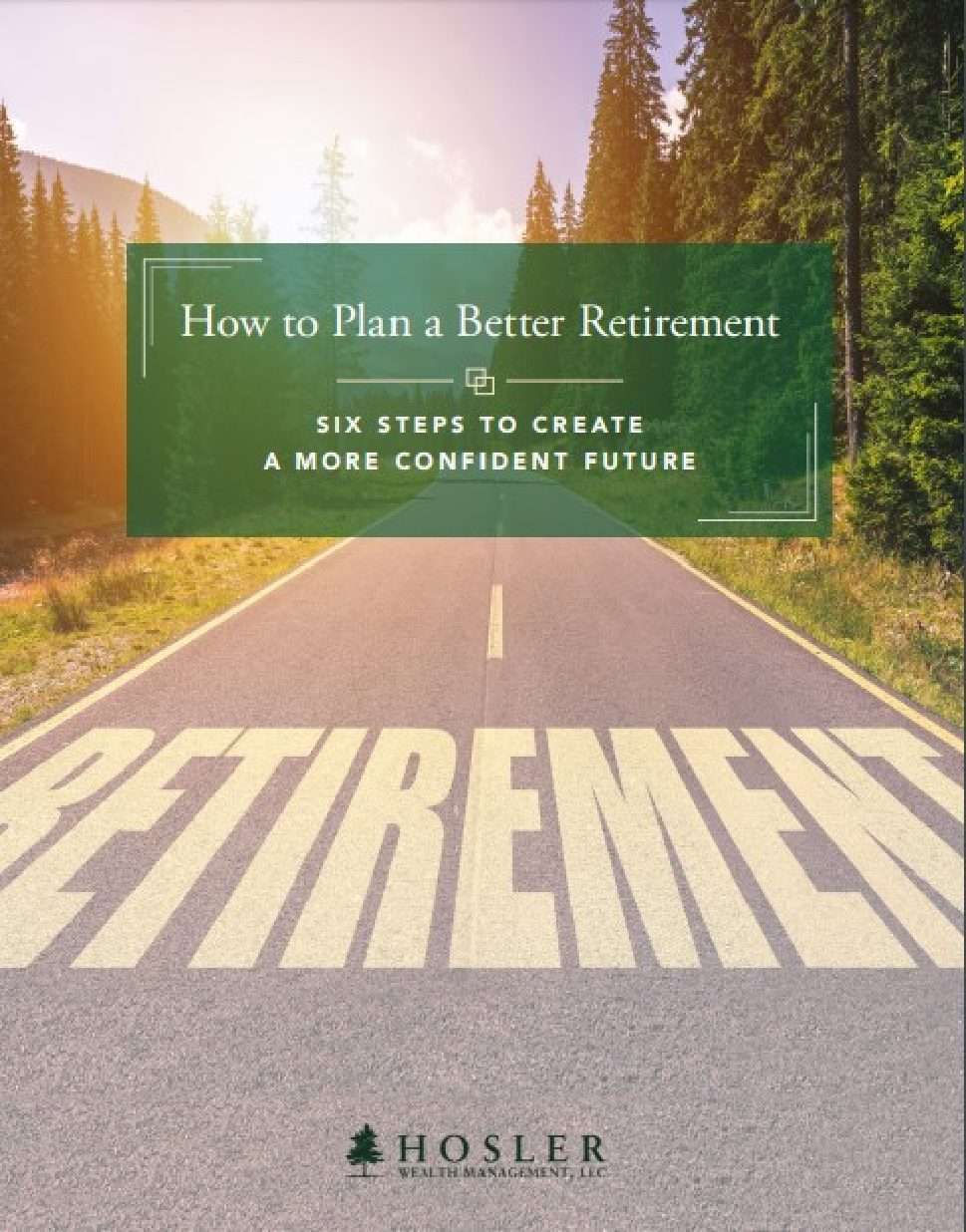In 2019, the US Government passed the SECURE Act, and one of the most significant ramifications was on what’s known as the stretch IRA. Many people who inherit an IRA, now have a ten-year window to withdraw those funds. Previously there was no time restraint.
There are five classes of individuals who have a different rulebook to play by – known as Eligible Designated Beneficiaries, or EDBs. Bruce explains who they are and what special benefits they receive.
Because of these rules, beneficiary forms are very important. Remember, once you die, that the beneficiary forms cannot be changed.
Also, there’s a new rule known as ALAR, or “At Least As Rapidly.” Bruce walks us through this unique and vital rule as well.
For more information about anything related to your finances, contact Bruce Hosler and the team at Hosler Wealth Management.
Call the Prescott office at (928) 778-7666 or our Scottsdale office at (480) 994-7342.
To listen to more Protecting & Preserving Wealth podcast episodes, click here.
Limitation of Liability Disclosures: https://www.hoslerwm.com/disclosures/#socialmedia
Podcast Host

Bruce Hosler is the founder and principal of Hosler Wealth Management, LLC., which has offices in Prescott and Scottsdale, Arizona. As an Enrolled Agent, CERTIFIED FINANCIAL PLANNER™ professional, and Certified Private Wealth Advisor (CPWA®), Bruce brings a multifaceted approach to advanced financial and tax planning. He is recognized as a prominent financial professional with over 27 years of experience and a seven-time consecutive *Forbes Best-In-State Wealth Advisor in Arizona. Bruce recently authored the book MOVING TO TAX-FREE™ Strategies For Creating Tax-Free Retirement Income And Tax-Free Lifetime Legacy Income For Your Children. www.movingtotaxfree.com.
In the Protecting & Preserving Wealth podcast, Bruce and his guests discuss current financial topics and provide timely answers for our listeners.
If you have a topic of interest, please let us know by emailing info@hoslerwm.com. We welcome your suggestions.
*2018-2024 Forbes Best In State Wealth Advisors, created by SHOOK Research. Presented in April 2024 based on data gathered from June 2022 to June 2023. 23,876 were considered, 8,507 advisors were recognized. Not indicative of advisor’s future performance. Your experience may vary. For more information, please visit.
Transcript
Jon “Jag” Gay: Welcome to the Protecting and Preserving Wealth podcast. I am Jon Jag Gay joined as always by Bruce Hosler from Hosler Wealth Management. Bruce, good to be back with you.
Bruce Hosler: Jon, great to be with you today. Thank you.
Jon: Talking about a really important topic today, too, Bruce, and that is reviewing and updating your IRA and Roth IRA beneficiary forms due to these new SECURE Act regulations.
Now, you and I were talking about this off air before we started recording. The SECURE Act was passed by the us government in 2019. Why are we having this discussion now recording this on August 31st, 2022.
Bruce: The IRS only in February of 2022 published or promulgated their interpretations of these regulations.
And they have now published the proposed regulations. That is how all of us, US taxpayers have to now live with these new RMD rules.
Jon: Got to love all the government red tape. So, Congress and the president passed the law three years ago, and now we wait for the IRS to interpret it. And all we have to go on right now is the current interpretation that’s out before it gets finalized.
Do I have that right?
Bruce: Yes, and, and just because it’s temporary doesn’t mean that it’s not effective. It is effective and it’s the best that we have to go off of, and so, we have to live with these regulations.
Jon: Okay, So, let’s rewind the clock a little bit. Bruce, and go back to that secure act in 2019. What happened in that law that was passed that affects what we’re talking about today.
Bruce: So, the big deal then was when someone died and they left their IRA, let’s say to their children; the children could stretch it out and take a little bit every year for the rest of their life. It was a great transfer, wealth transfer tool, but now they have to pull all this money out and pay the taxes on it within just 10 years for most beneficiaries.
Jon: Okay, So, I’m imagining in that case that you had to take the money out over 10 years. That means if there are taxes that would be applied there as the beneficiary, government wants their money, you have to pay those taxes over those 10 years, right?
Bruce: That’s right. So, the government gets their money in 10 years.
That’s the key that they’re looking for.
Jon: So, you mentioned the IRS promulgating their proposed regulations explaining how they’re interpreting it as of right now, what else did they say?
Bruce: Well, in addition to confirming that they’re killing the stretch for all, but five special classes of IRA beneficiaries, and these special beneficiaries are called EDBs or eligible designated beneficiaries.
They made IRA beneficiary planning, way more complex.
Jon: All right, before we dive into those complexities, uh, you mentioned five special classes of EDBs- eligible designated beneficiaries. What are those five classes and what benefits do they have that the rest of us don’t?
Bruce: So, these five classes include number one, a surviving spouse.
So, for married couples, their surviving spouse gets to continue to stretch it over their remaining life if they want to.
Jon: Mm-hmm.
Bruce: That’s great. The second one is minor children of the account owner that are 21 years or younger.
Jon: Okay.
Bruce: This does not include grandchildren. So, if you think about most IRA owners don’t die until they’re in their seventies, eighties, or nineties.
So, it’s only your minor children. So, this only affects IRA owners that die probably prematurely or in their youth.
Jon: Mm-hmm.
Bruce: Number three is if you have a beneficiary that’s disabled, So, they must qualify under strict IRS rules, but if they’re disabled, number four, chronically ill individuals. So, somebody has a chronic illness and that affects them, they could also, qualify. And then finally, individuals that are not more than 10 years younger than the IRA owner. What I want you to think of there is your brother and sisters. If you’re 80 years old, people that are within 10 years of you are usually your siblings. Those are the five EDBs that are available to continue to the stretch IRA.
Jon: Two follow-up questions here. They are 10 years younger, but not older?
Bruce: They cannot be more than 10 years younger. So, older is okay. Just can’t be younger than 10 years.
Jon: Okay.
And then chronically ill without getting too far into the weeds here, I’d imagine there are a lot of special, uh, designations that you would have to qualify for, for chronically ill.
Just like you mentioned about, uh, disabled.
Bruce: Yes – yes. So, disabled may be a disability, you know, whether mental or physical. Chronically ill is maybe somebody that has a chronic illness makes it. So, they can’t work or they’re chronically ill and, and incapacitated in that way.
Jon: Okay. So, those five EDBs – eligible designated beneficiary classes.
What special benefits did they get Bruce?
Bruce: So, each of these are exempt from that 10-year withdrawal rule. And so, they get to stretch the RMD over their remaining life. Just like pre to 2020 before the SECURE Act. And, so, think of it like a spouse, maybe you have a younger spouse, and the husband dies. She might only be only 60 years old.
She could stretch that out over the next 30 years only taking 1/30th per year. Allows that IRA to grow a long-time tax deferred.
Jon: So, outside those five classes, what you’re saying is most, all other IRA, beneficiaries are going to have to distribute that IRA out and pay the taxes like we said earlier; within 10 years after the IRA owner dies, right?
Bruce: That’s correct. And the IRA has now become a terrible transfer tool for transferring Wealth. And we’re going to talk about that in the next episode.
Jon: The old radio DJ in me likes to tease there, Bruce.
Bruce: Okay.
Jon: Is there anything else our listeners should know about regarding these new regulations that have gone into place?
Bruce: Yes, for sure. The one item that stands out is the determination of your status as a beneficiary, is now locked in and decided on the date of death of the IRA or 401k account owner. This status cannot be changed once the IRA owner dies.
Jon: And this is Something we’ve talked about in previous podcast, Bruce, and that is the importance of estate planning.
It Sounds like whatever beneficiary form is in place at the time of death, that is really important, because that’s now ironclad and set in stone, right?
Bruce: That is for sure the exact thing that we want to talk to our, our listeners about that IRA beneficiary form has become very important and they are more powerful now for your IRA and your 401k dollars, then your trust or your will. Your 401k and IRA beneficiary reforms, they Trump everything else you’ve done legally, no matter what your trust says or what your will says.
Jon: Wow.
Bruce: The beneficiary form controls the IRA and the 401k dollars when you die. And now it also, determines the status of your beneficiaries at the time of death.
So, there’s no do over. There’s no way to correct this after you die, you must get it right the first time when you fill out that beneficiary form.
Jon: So, if someone dies, there’s no way to go back and change that beneficiary form, uh, to match their will or trust. And is that new that it’s, it’s now set in stone?
Was that not the case before?
Bruce: It was kind of the case before, but the new regulations have locked that in because of these changes of types of beneficiaries. So, the EDB or the non EDB beneficiary that is locked in as of the date of death. So, uh, yes, it’s even more locked in with the new regulations now.
Jon: So, I’d imagine this is why you got to keep those IRA, 401k, life insurance, annuity beneficiary forms current at all times.
Bruce: That’s right. You need to review that every year and make sure that they’re current in what you want and what your wishes are.
Jon: I’m sure, without naming names, Bruce, you’ve seen horror stories at Hosler Wealth Management of folks that didn’t update their beneficiaries. Whether it was a marriage, a divorce, and all-of-a-sudden ex-wife or ex-husband has a claim to it because they never changed the forms, right?
Bruce: That’s correct. We have seen some horror stories. And the other thing is, is people that are just indecisive and haven’t finished their paperwork that can leave a nightmare for the heirs and the beneficiaries.
Jon: Right. They say that when you’re doing estate planning, it’s not for your benefit. It’s for the benefit of those you love.
So, they’re not stuck in probate and they’re not dealing with all this, uh, mountain paperwork, nightmare. Uh, any other gotchas for our listeners, with these new regulations, Bruce?
Bruce: There are some new regulations that we have never seen before. There is a new rule called ALAR A-L-A-R, which stands for at least as rapidly.
Jon: Mm-hmm.
Bruce: So, the least as rapidly rule.
Jon: Okay. What does that do?
Bruce: So, this force is a beneficiary to take RMDs, at least as rapidly as the IRA owner was taking them. If the IRA owner was older than their required beginning date, their R B D you know, that date that you must start taking your required minimum distributions. Now, for right now, that date is April 1st, not April 15th, April 1st of the year after you turn 72 years old.
Jon: So, R B D is when you have to take out the RMDs. So, if you’ve got Somebody who’s taking out the RMDs, you have to take it out as the heir, at least as quickly, or at least as rapidly to the letter of the law as the individual was prior to that.
Bruce: Yes, at the same rate. And you have to take the minimum of at least as rapidly as for the years, one through nine, after the IRA owner dies.
And then in the 10th year, you have to take it all out and distribute the entire IRA, recognize the taxable income and pay the taxes.
Jon: That Sounds expensive. I mean, it Sounds like my beneficiaries could be forced to look for better estate planning information. So, they know all the options that might be available to them and more tax advantageous, right?
Bruce: That’s right, Jag, for certain. And we’re seeing these regulations become more problematic every time Congress passes another law.
Jon: Are there any obvious actions that our listeners today can take advantage of?
Bruce: Yes. folks, I want you to begin thinking about controlling the tax rate that you may be forced to pay in the future on your IRA or your 401k.
You can take control today of the tax rate. By choosing to convert your IRA or your 401k to a Roth IRA or 401k right now while the tax rates are lower and the Tax Cuts & Jobs Act of 2017 is in effect. Before it sunsets on December 31st, 2025. If you leave your IRA to your children, you may be forcing them into a much higher future tax rate as the tax rates rise in the coming years.
Jon: Yeah, that’s what we talked about in previous episodes. You can go back and listen that tax cuts and jobs act that’s going to sunset unless Congress does anything. And there’s no guarantee as we know that Congress will do anything. Uh, if, if that sunsets as planned. Those tax cuts from 2017 are going to go back up, which like you said, makes a really good reason to make that conversion now.
And of course, every individual situation is different. That’s why you would want to talk to Bruce and the team at Hosler Wealth Management. Any other tips as we wrap up Bruce?
Bruce: I guess the final thing I want to leave our listeners with is I want you to make sure that your charitable bequest – that is if you’re leaving money when you die to anyone, that you do that from your IRA and not from your taxable money in your trust or a taxable account. Your IRA will not receive a step up. Your beneficiaries will have to pay the tax on it unless the beneficiary is a charity. So, folks leave your IRA to the charity. If you’re going to leave any monies to a charity and leave your other monies to your loved one. This applies to you if you’re going for certain to leave some monies to a charity. That’s it for today folks.
Jon: Talking about the charities, talking about the Roth conversions, and I know in our next Episode, Bruce, we’re going to talk about some other strategies. In the meantime, if one of our listeners wants to come talk to you and your team at Hosler Wealth Management what are the best ways to reach you?
Bruce: You can reach us at our website. Hosler, https://hoslerwm.com. You can call us at (480) 994-7342. Or in Prescott (928) 778-7666. And of course, our website, Hosler, https://hoslerwm.com. You can sign up for an appointment right on the website. I look forward to hearing from you folks and answering your questions whenever you have a chance to reach out to us.
Jon: Bruce, really good actionable tips for our listeners today. You don’t want to wait on this stuff. We’ll talk again Soon.
Bruce: Thanks folks.
Jon: Securities and advisory services offered through Commonwealth Financial Network® member FINRA/ SIPC a registered investment advisor. Forward looking commentary should not be misconstrued as investment or financial advice.
The advisor associated with this podcast does not monitor for comments, and any comments should be given directly to the office at the contact information specified. Any tax advice contained in this communication, including any attachments is not intended or written to be used and cannot be used for the purpose of, 1) avoiding federal or state tax penalties or 2) promoting marketing, or recommending to another party, any transaction or matter address herein. The accuracy, completeness, and timeliness of the information contained in this podcast cannot be guaranteed. Accordingly, Hosler Wealth Management, LLC does not warranty guarantee or make any representations or assume any liability with regard to financial results based on the use of the information in this podcast.
Comments are closed.




